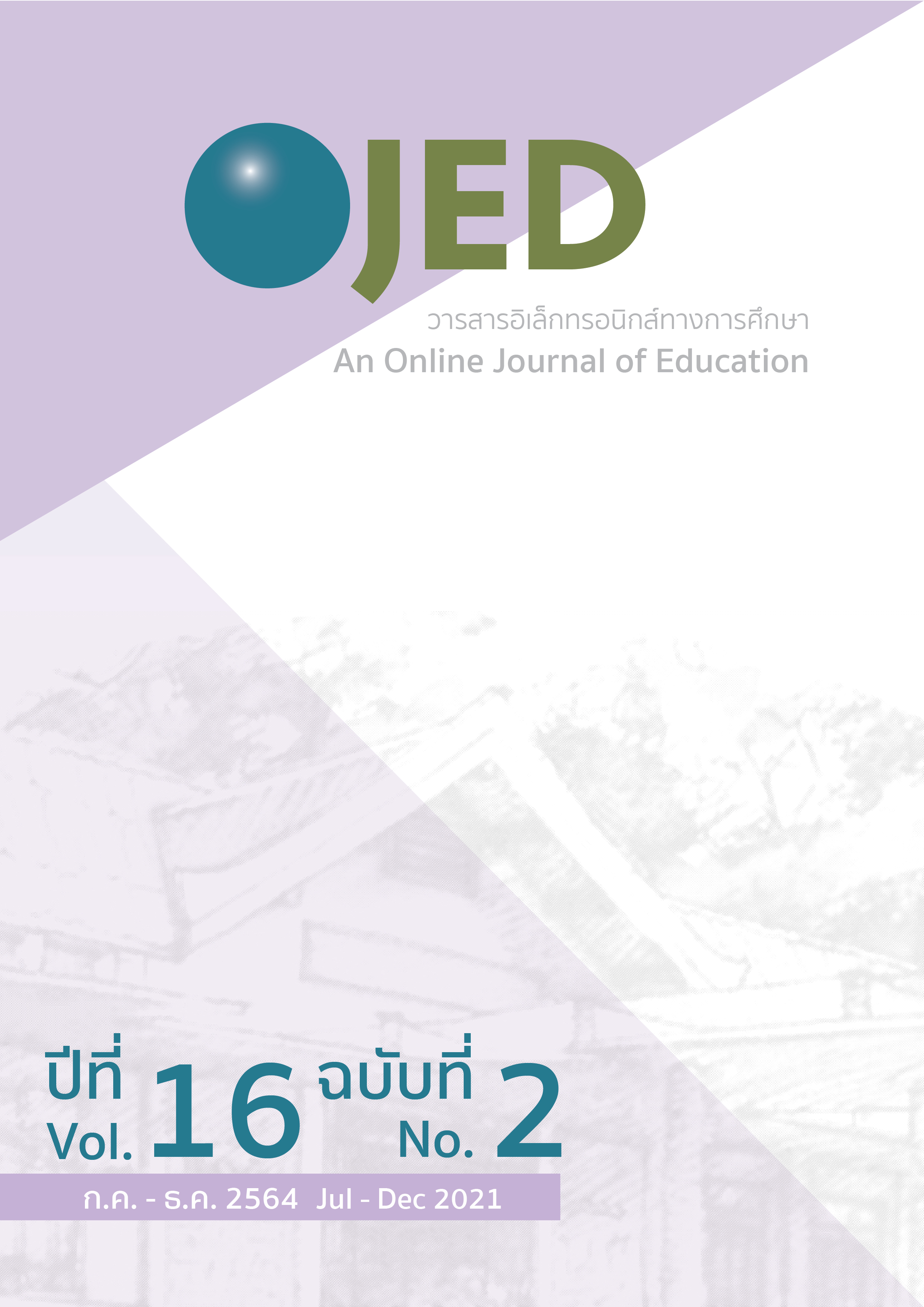Preschool Teacher’s Roles in Organizing Active Learning in School Under Bangkok Primary Educational Service Area Office Leelawadee Group
DOI:
https://doi.org/10.14456/ojed.2021.35Keywords:
preschool teacher’s roles, organizing active learning, active learningAbstract
The purpose of this research is to study the role of kindergarten teachers in managing proactive education in two aspects, namely the media and environment preparation aspect and the learning support aspect. The population used in this research is 76 kindergarten teachers in Leelawadee group (Alias) of Bangkok Primary Educational Service Area Office. The tools used in this research are surveys and interviews. Data are analyzed by analyzing frequency distribution, finding percentage value and the average of standard deviation, and analyzing the content. It has been found that kindergarten teachers have the most role in managing proactive education overall ( =4.63). The aspect with the highest average performance score is media and environment preparation aspect ( =4.64) followed by learning support aspect ( =4.62). After considering each aspect, it is found that overall in the media and environment preparation aspect, teachers perform the most in preparing media which facilitate education, having the highest average score ( =4.65 ) This is followed by managing space and time for education ( =4.64) and creating learning atmosphere ( =4.61), respectively. In addition, overall in the learning support aspect, teachers perform the most in finding the children’s wants, having the highest average score ( =4.68) This is followed by encouraging children to act by themselves ( =4.60), and facilitating children’s learning ( =4.57), respectively
References
ณัฏฐภรณ์ หลาวทอง. (2559). การสร้างเครื่องมือการวิจัยทางการศึกษา. กรุงเทพฯ: โรงพิมพ์แห่งจุฬาลงกรณ์มหาวิทยาลัย.
ประคอง กรรณสูต. (2542). สถิติเพื่อการวิจัยทางพฤติกรรมศาสตร์ (พิมพ์ครั้งที่ 3). กรุงเทพฯ: สำนักพิมพ์แห่งจุฬาลงกรณ์มหาวิทยาลัย.
ปรียา สมพืช. (2559). การจัดการเรียนรู้เชิงรุกโดยใช้รูปแบบการเรียนการสอนด้วยกรณีศึกษา. วารสารวิจัยราชภัฎพระนคร สาขามนุษยศาสตร์และสังคมศาสตร์, 11(2), 260-270.
พิมพ์พันธ์ เดชะคุปต์ และพเยาว์ ยินดีสุข. (2561). การเรียนรู้เชิงรุกแบบรวมพลัง กับPLCเพื่อการพัฒนา. กรุงเทพฯ: โรงพิมพ์แห่งจุฬาลงกรณ์มหาวิทยาลัย.
มูลนิธิสถาบันวิจัยและพัฒนาการเรียนรู้ แผนงานการเรียนรู้สู่สุขภาวะในสถานศึกษา. (2551). เติมเต็มครูปฐมวัย...ด้วยหัวใจ BBL. กรุงเทพฯ: บริษัท พี.เอ.ลีฟวิ่ง จำกัด.
เยาวเรศ ภักดีจิตร. (2557). เอกสารประกอบการเสวนาทางวิชาการ “วันส่งเสริมวิชาการสู่คุณภาพการเรียนการสอน”. สืบค้นจาก http://apr.nsru.ac.th//Act_learn/myfile/27022015155130_article.docx.
ลักขณา สริวัฒน์. (2557). จิตวิทยาสำหรับครู. กรุงเทพฯ: โอ.เอส.พริ้นติ้ง เฮ้าส์.
สำนักงานคณะกรรมการการศึกษาขั้นพื้นฐาน กระทรวงศึกษาธิการ. 2560.รายงานผลการประเมินพัฒนาการนักเรียนที่จบหลักสูตรการศึกษาปฐมวัยพุทธศักราช 2546 ปีการศึกษา 2559. กรุงเทพฯ: โรงพิมพ์ชุมนุมสหกรณ์การเกษตรแห่งประเทศไทย จำกัด.
สำนักงานคณะกรรมการการศึกษาขั้นพื้นฐาน. (ม.ป.ป.).นโยบายสำนักงานคณะกรรมการการศึกษาขั้นพื้นฐาน
ปีงบประมาณ พ.ศ. 2561. สืบค้นจาก https://www.obec.go.th/wp- content/uploads/2018/08/obec61.pdf?fbclid=IwAR3IINCOfoRm0yNWAJlcDvcZwsGz- zVAbR47UXIS6DT3OqYCOTH-JIkAmr8.
สำนักงานเขตพื้นที่การศึกษาประถมศึกษากรุงเทพมหานคร. (2560). แผนพัฒนาคุณภาพการศึกษาระยะ 4 ปี
ปีการศึกษา 2560-2563 สำนักงานเขตพื้นที่การศึกษาประถมศึกษากรุงเทพมหานคร. สืบค้นจากhttp://www.esbuy.net/_files_school/00000374/news/00000374_1_20190704-001744.pdf.
สำนักงานเลขาธิการสภาการศึกษา กระทรวงศึกษาธิการ. (2550). การเรียนรู้ของเด็กปฐมวัยไทย: ตาม
แนวคิดไฮสโคป. กรุงเทพฯ: ห้างหุ้นส่วนจำกัด วี.ที.ซี. คอมมิวนิเคชั่น.
อาภรณ์ ใจเที่ยง. (2550). หลักการสอน. (พิมพ์ครั้งที่ 4). กรุงเทพฯ: โอ.เอส.พริ้นติ้ง เฮ้าส์.
อุษา คงทอง, ชาตรี เกิดธรรม, มานิต ทองจันทร์, พิทักษ์ นิลนพคุณ, สุธี พรรณหาร, พนิดา ชาตยาภา และ
ฐิติพร พิชญกุล. (2553). คู่มือการจัดระบบการเรียนการสอนที่ยึดผู้เรียนเป็นศูนย์กลางการเรียนรู้. มหาวิทยาลัยราชภัฎวไลยอลงกรณ์ ในพระบรมราชูปถัมภ์.
Hohnmann, M., & Weikart, P. D. (2002). Educating Young Children: Active Learning Practices for preschool and child care programs. Ypsilanti, Mich: High/Scope Press.
Kelly Marilyn. (2001). Active Learning in the classroom: Common Understanding. The
Primary Program: Growing and Learning in the Heartland. Retrieved from
http://nde.ne.gov/OEC/pubs/pri_pro/ALCU.pdf
Kudryashova, A., Gorbatova, T., Rybushkina, S., & Lvanova, E. (2016). Teacher’s Roles to Facilitate Active Learning. Mediterranean Journal of Social Sciences MCSER Publishing, Rome-Italy, 1(7), 460-466. Doi:10.5901/mjss.2016.v7n1p460
Winterbottom, M. (2017). Active Learning. Cambridge Assessment. Retrieved from https://www.cambridgeinternational.org/Images/271174-active- learning.pdf?fbclid=IwAR00PHWoEfAktL1YAjy20dLztGS- LNaGRm1MMpfZ1cSDRuWkViHcrYbE_9Y
Downloads
Published
How to Cite
Issue
Section
License
Copyright (c) 2021 An Online Journal of Education

This work is licensed under a Creative Commons Attribution-NonCommercial-NoDerivatives 4.0 International License.




